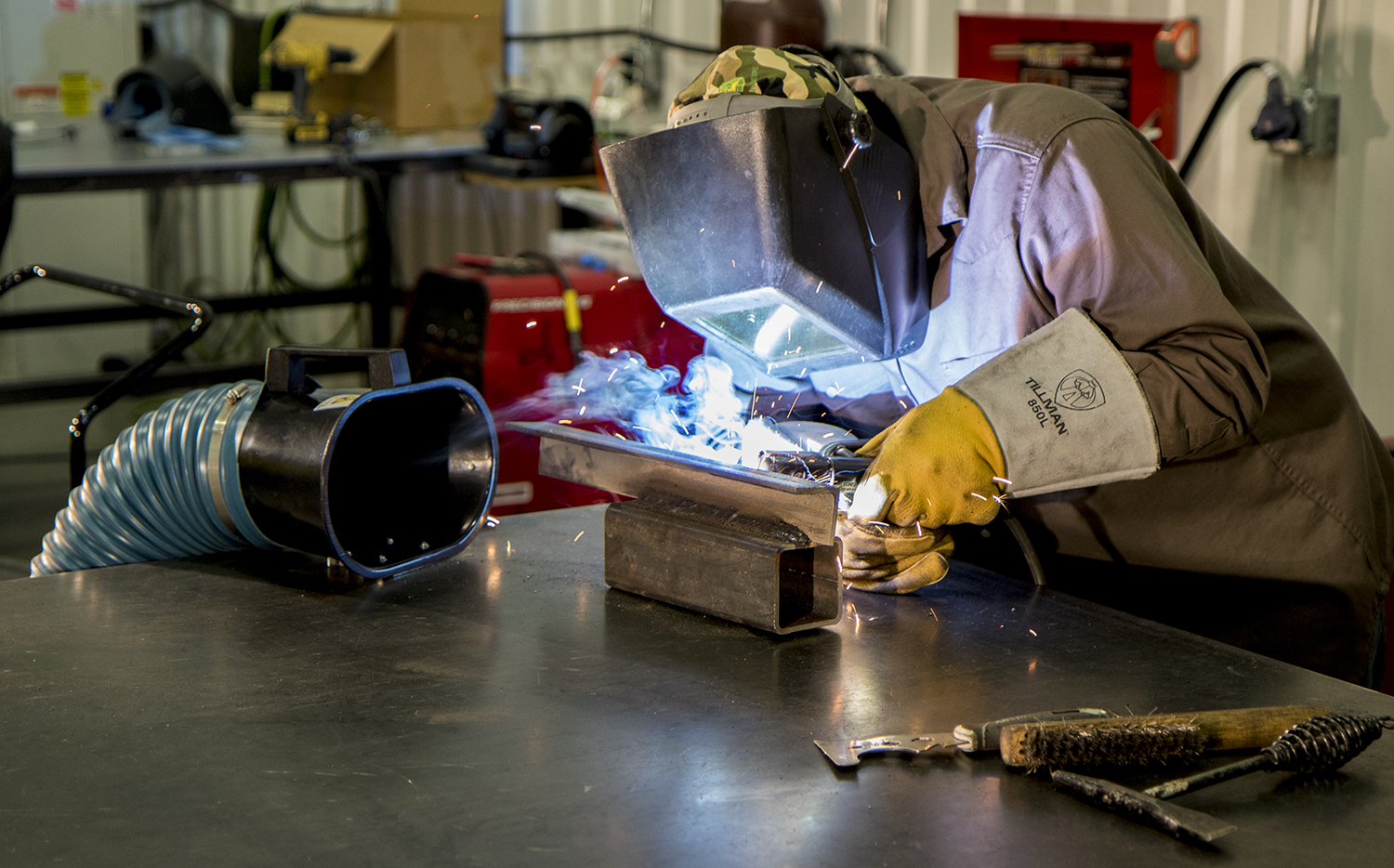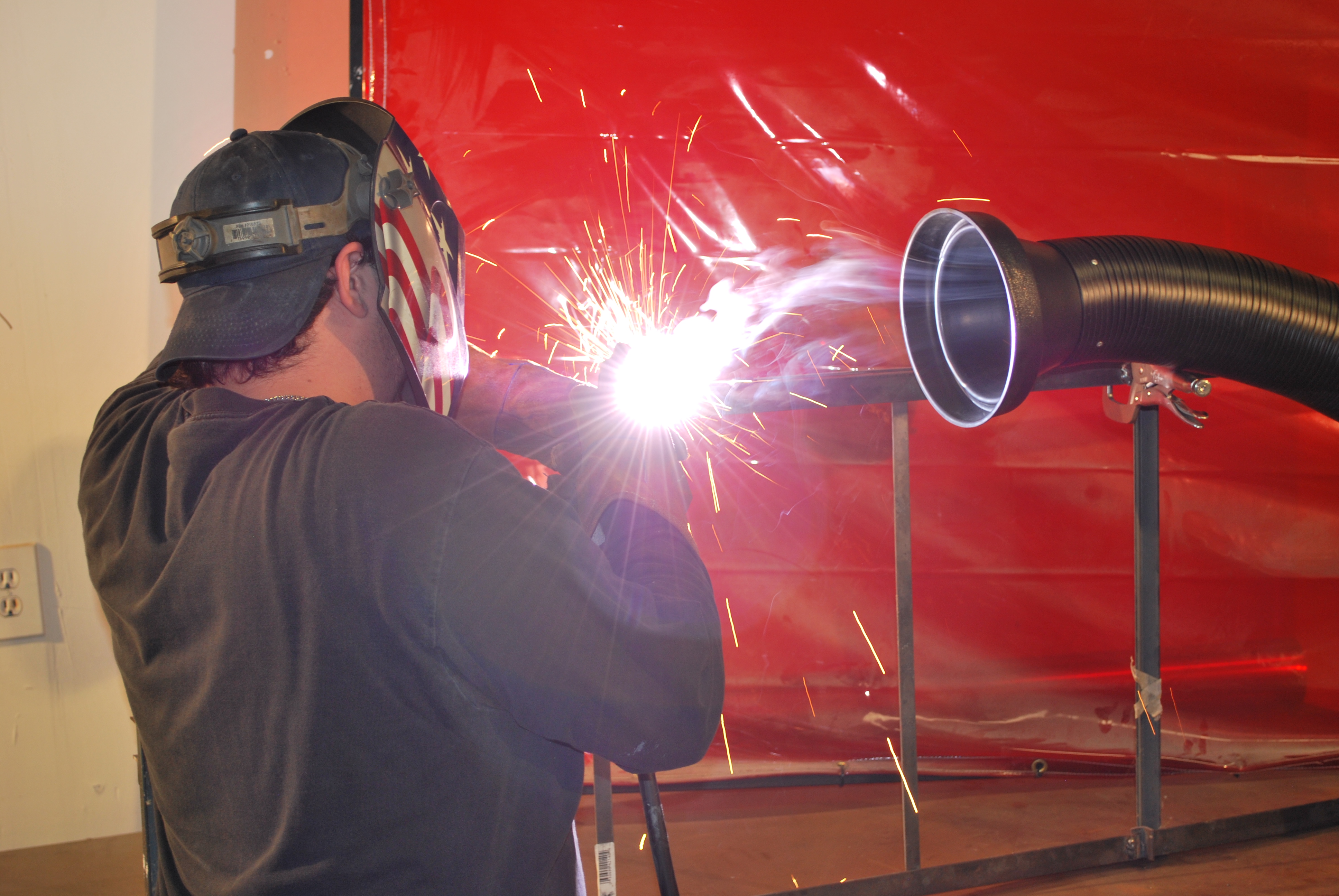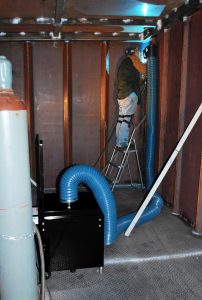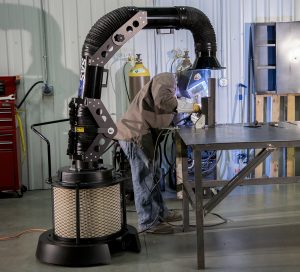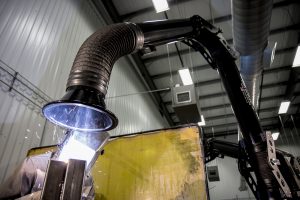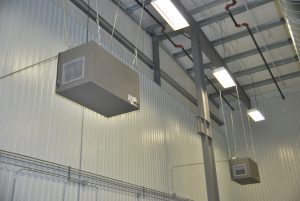Welding produces hazardous fumes that must be controlled to safeguard employee respiratory and overall health. Welding exposes metals to high levels of heat creating gaseous fumes and nano-particles. The hazards of welding fumes depend on the contents of the metal, the type of welding process, and the frequency of welding. Fume extractors must be utilized to protect employees from the hazards of welding fumes as NIOSH states that respirators alone do not provide adequate protection1.
Metal Composition Effect on Hazards of Welding Fumes
First, the type of metal and concentration of each substance determines the level of severity of health hazards for welding fumes. The most common types of metal for welding are stainless steel, mild steel, and galvanized steel. The hazards of welding fumes by metal type are discussed below as well as a chart summarizing government regulations for each metal type.
| Substance | OSHA PEL | NIOSH REL | ACGIH TLV™ |
| Hexavalent Chromium | 5 µg/m3 | 0.2 µg/m3 | 0.2 µg/m3 ST: 0.5 µg/m3 |
| Nickel (Soluble) (Insoluble) (Elemental) |
1 mg/m3 1 mg/m3 1 mg/m3 |
0.05 mg/m3 0.1 mg/m3 0.5 mg/m3 |
0.1 mg/m3 0.2 mg/m3 1.5 mg/m3 |
| Iron Oxide | 10 mg/m3 | 5 mg/m3 | 5 mg/m3 |
| Manganese | 5 mg/m3 | 0.2 mg/m3 | 0.2 mg/m3 0.02 mg/m3 (Respirable) |
| Zinc Oxide (Fume) (Respirable) (Total Dust) |
5 mg/m3 5 mg/m3 15 mg/m3 |
5 mg/m3 5 mg/m3 10 mg/m3 |
2 mg/m3 2 mg/m3 — |
| Copper (Fume) (Dust) |
15 mg/m3 5 mg/m3 |
10 mg/m3 5 mg/m3 |
10 mg/m3 1 mg/m3 |
| Aluminum (Fume) (Dust) |
5 mg/m3 15 mg/m3 |
5 mg/m3 10 mg/m3 |
— |
Stainless Steel
Hexavalent Chromium Fumes – known human carcinogen for lung cancer3. Small amounts of exposure has lasting health effects. Can cause other types of cancer – sinonasal, oral, liver, bladder, and esophagus cancers4. Other effects: nose and throat irritation, asthma, wheezing, and damage to the skin, eyes, kidneys and liver5
Nickel Fumes – causes eye, nose, or throat irritation. Can cause dermatitis and lung problems6.
Mild Steel – an increased risk of lung cancer resulted from the inhalation of mild steel welding fumes despite less exposure to carcinogenic compounds7.
Iron Oxide Fumes – causes siderosis, a benign lung disease from particle lung deposit6. Siderosis is non-cancerous but can cause nasal and lung irritation.
Manganese Fumes – can cause manganism – condition similar to Parkinson’s disease and results in trembling, stiffness, slowing of motor movement, and in severe cases anxiety, depression and aggression8. Can also cause lung, liver, or kidney damage.
Galvanized Steel
Zinc Oxide Fumes – can lead to developing a condition called metal fume fever. Metal fume fever creates symptoms similar to the flu resulting in chills, muscle aches, nausea, fever, difficulty breathing, and decreased pulmonary function9.
Other Metal Types
Copper Fumes – may cause irritation in the eyes, nose or throat6.
Aluminum Fumes – irritates the respiratory system6.
Other Metal Dust – causes eye irritation, eye damage, and respiratory irritation6.
Types of Welding Effect on Hazards of Welding Fumes
Next, different types of welding affects the concentration of hazardous welding fumes thus increasing the health hazards. Below are the different types of welding listed in order of most fumes produced to the least amount of fumes by metal type.
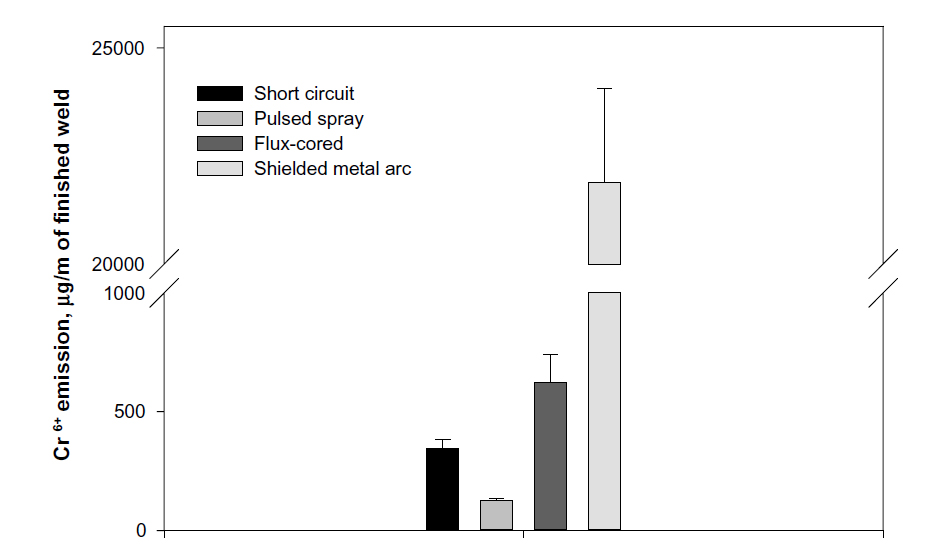
Figure 2: Hexavalent Chromium Emission rates for 4 Welding Processes10
| Welding Type | Mean Exposure |
| Shielded Metal Arc Welding | 1.4 µg/m3 |
| Gas Metal Arc Welding | 1.3 µg/m3 |
| Gas Tungsten Arc Welding | 0.14 µg/m3 |
1) Shielded Metal Arc Welding (SMAW) – produces double to quadruple amount of concentrations of hexavalent chromium (See Figure 2 above)10. In several studies, shielded metal arc welding consistently poses the most hazards for welding fumes due to high concentrations of fumes3. See Figure 3 as well.
2) Gas Metal Arc Welding (GMAW) – concentrations are very close to shielded metal arc welding (Figure 3)1. Other types of gas metal arc welding such as short circuit and pulsed spray have much less fume production (Figure 2)10. Short circuit produces a quarter of the shielded metal arc welding hexavalent chromium fumes10. Pulsed spray welding has the least amount of hexavalent chromium fume concentrations.
3) Flux Cored Arc Welding – From Figure 2, you can see flux core arc welding produces about half the amount as shielded metal arc welding10.
4) Gas Tungsten Arc Welding – From Figure 3, gas tungsten arc welding produces much less hexavalent chromium than gas metal arc and shielded metal arc welding1.
Frequency Effect on Hazards of Welding Fumes
| Worker Type | Health | Mean Cancer Risk |
| Maintenance | Asthma | 0.34% |
| Healthy | 0.3% | |
| Project | Asthma | 1.14% |
| Healthy | 1.04% |
Lastly, the hazards welding fumes and lung cancer risks can vary depending on if a welder works as a project or maintenance worker. See Figure 4 for the mean cancer risk for a study of 30 Iranian workers over a lifetime. The main contributing factory was whether a welder worked full-time or did it on selective maintenance type basis. This study also compared previous respiratory ailments such as asthma to health workers, but the difference was minimal11. In a 2017 Canadian population study, full-time welders chance of developing health hazards were compared to occasional welders12. The full-time welders had a 16% increased chance of developing lung cancer, 78% risk for mesothelioma, 40% increased risk for bladder cancer and 30% increased risk of kidney cancer. Occasional welders had a 12% increased risk in developing lung cancer and 74% increased risk for mesothelioma with no increased risk for bladder or kidney cancer. This may mean that even minimal exposure to welding fumes on a part-time basis can pose health hazards as serious as developing cancer.
Welding Fumes Control Solutions
To properly control welding fumes, Sentry Air Systems offers a wide variety of fume control solutions. Sentry Air Systems provides benefits of flame retardant hoses and filter media, as well as small portable options adaptable for all types of welding situations. A self-supportive arm can be directed at the welding fume source or a “python” extra flexible hose allows the operator to attach the magnetic hood directly to a nearby surface.
Model 300 Welding Fume Extractor – SS-300-WFE
Model 400 Python Portable Fume Extractor – SS-400-PYT
Rugged Air – Cleanable Filter Welding Fume Extractor – SS-RGD-7HDA
Model 500 Heavy Duty Industrial Welding Fume Extractor – SS-500-WFE-MP1
Model 2000 Ambient Air Cleaner – SS-2000-FH
Reduce hazards of welding fumes today with welding fume control solutions!
Feel free to give us a call to help you select a fume extractor for your welding site! — 1-800-799-4609
Sources
1. Department of Health and Human Services. “Criteria for a Recommended Standard: Occupational Exposure to Hexavalent Chromium.” Sept 2013, pp 2, 22, 38, 84, 99. https://www.cdc.gov/niosh/docs/2013-128/pdfs/2013_128.pdf?id=10.26616/NIOSHPUB2013128.
2. Occupational Safety and Health Administration. “OSHA Annotated Table Z-1,” https://www.osha.gov/dsg/annotated-pels/tablez-1.html.
3. U.S. Department of Health and Human Services. “Chromium Hexavalent Compounds.” Report on Carcinogens, Fourteenth Edition, 3 Nov. 2016, https://ntp.niehs.nih.gov/ntp/roc/content/profiles/chromiumhexavalentcompounds.pdf.
4. Higashi, Toshiaki; Kawaguchi, Takako; Morimoto, Yasuo; Noguchi, Shingo; Suzuki, Hideaki; Tanaka, Fumihiro; Ueno, Susumu; Yatera, Kazuhiro. “Cancer Risks of Hexavalent Chromium in the Respiratory Tract.” Journal of UOEH, The University of Occupational and Environmental Health Japan, 2018 Volume 40 Issue 2, pp 159, 163, 168. https://www.jstage.jst.go.jp/article/juoeh/40/2/40_157/_article.
5. Occupational Safety and Health Administration. “Health Effects.” Hexavalent Chromium. https://www.osha.gov/SLTC/hexavalentchromium/healtheffects.html.
6. Canadian Centre for Occupational Health and Safety (CCOHS). “Welding – Fumes and Gases,” Government of Canada, 2016 Oct 3. https://www.ccohs.ca/oshanswers/safety_haz/welding/fumes.html.
7. Andrews, R.N.; Antonini, J.M.; Battelli, L.A.; Cumpston, J.B.; Cumpston, J.L.; Dodd, T.; Donlin, M.; Erdely, A.; Falcone, L.M.; Kashon, M.L.; Kodali, V.; Leonard, H.D.; McKinney, W.; Salmen, R.; Stone, S.; Zeidler-Erdely, P.C.. “Inhlational of Iron-Abundant Gas Metal Arc Welding-Mild Steel Fume Promotes Lung Tumors in Mice,” Toxicology, Elsevier, 2018, Vol 409, p 24-32. Retrieved from: https://www.sciencedirect.com/science/article/pii/S0300483X18301380.
8. The National Institute for Occupational Safety and Health (NIOSH). “Manganese,” Centers for Disease Control and Prevention, 2018 June 26. https://www.cdc.gov/niosh/topics/manganese/default.html.
9. The National Institute for Occupational Safety and Health (NIOSH). “Zinc Oxide,” NIOSH Pocket Guide to Chemical Hazards, 2016 Apr 11. https://www.cdc.gov/niosh/npg/npgd0675.html.
10. Keane MJ. “An Evaluation of Welding Processes to Reduce Hexavalent Chromium Exposures and Reduce Costs by Using Better Welding Techniques.” Environmental Health Insights. 2014; 8(Suppl 1):47-50. https://www.ncbi.nlm.nih.gov/pmc/articles/PMC4270263/.
11. Barkhordari, Abolfazl et al. “Cancer Risk Assessment in Welder’s Under Different Exposure Scenarios.” Iranian Journal of Public Health 43.5 (2014): 666–673. https://www.ncbi.nlm.nih.gov/pmc/articles/PMC4449415/.
12. Demers, Paul A.; Harris, M. Anne; MacLeod, Jill S.; Peters, Paul A.; Tjepkema, Michael. “Cancer Risks among Welders and Occasional Welders in a National Population-Based Cohort Study: Canadian Census health and Environmental Cohort,” Safety and Health at Work: 8, 2017, p. 261. Retrieved from: https://www.ncbi.nlm.nih.gov/pmc/articles/PMC5605892/.

 Made in the USA
Made in the USA
